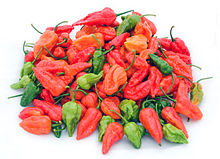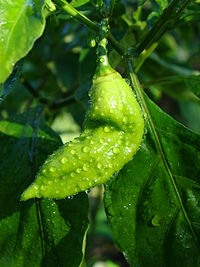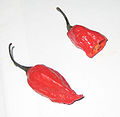- Bhut Jolokia chili pepper
-
Bhut Jolokia chili 
Fresh Bhut JolokiaDetails Species C. chinense and C. frutescens Cultivar 'Bhut Jolokia' The Bhut Jolokia[1][2] (Assamese: ভূত জলকীয়া bhut jôlôkia; Bangla: নাগা মরিচ naga morich; Manipuri: উমোরোক umorok[3][4]), as it is commonly known—also known variously by other names (see etymology section below) in its native region, sometimes Naga Jolokia—is a chili pepper previously recognized by Guinness World Records as the hottest pepper in the world. The pepper is typically called the ghost chili or ghost pepper by U.S. media.[5][6][7]
The Bhut Jolokia is an interspecific hybrid cultivated in the Assam region of northeastern India and parts of neighbouring Bangladesh.[8][9] It grows in the Indian states of Assam, Nagaland and Manipur, and the Sylhet region of Bangladesh. It can also be found in rural Sri Lanka where it is known as Nai Mirris (cobra chili). There was initially some confusion and disagreement about whether the Bhut was a Capsicum frutescens[10] or a Capsicum chinense pepper, but DNA tests showed it to be an interspecies hybrid, mostly C. chinense with some C. frutescens genes.[11]
In 2007, Guinness World Records certified the Bhut Jolokia as the world's hottest chili pepper, 401.5 times hotter than Tabasco sauce.[12] On December 3, 2010, the Bhut Jolokia was replaced as the hottest known chili pepper by the Naga Viper pepper, which has an average peak Scoville rating more than 300,000 points higher than an average Bhut Jolokia - but still not higher than the hottest ever recorded Dorset Naga.[13] In February 2011, Guinness World Records awarded the title of "World's Hottest Chilli" to the Infinity chilli grown in Grantham, England.[14] This chilli rates at 1,067,286 units on the Scoville scale.[15] Later the same month, on February 25, 2011, the title returned to the Naga Viper pepper with a rating of 1,382,118 Scoville Heat Units (SHU).[16] The current "world's hottest" is the Trinidad Scorpion Butch T, officially tested at 1,463,700 SHU.[17] These figures are highly controversial among the pepper growing community and tests with more rigorous scientific standards are yet to be conducted on the many various peppers vying for "world's hottest" status.
Contents
Etymology
The pepper is called by different names in different regions. An article in the Asian Age newspaper stated that experts in Assam are worried about a distortion of the colloquial nomenclature of "Bhot" to "bhut", saying that this word was misinterpreted by the (Western) media to mean "ghost".[18] The article stated that people living north of the Brahmaputra River call the pepper "Bhot jolokia", "Bhot" meaning "of Bhotiya origin", or something that has come from the hills of adjoining Bhutan; on the southern bank of the river Brahmaputra, this chili becomes Naga jolokia, believed to have originated from the hills of Nagaland.[18] An alternative source for Naga jolokia is that the name originates from the ferocious Naga warriors who once inhabited Nagaland.[19] Further complicating matters, a 2009 paper, published in the Asian Agri-History journal, coined the English term "Naga king chili" and stated that the most common Indian (Assamese) usage is bhoot jolokia,[20][21] which refers to the chili's large pod size, and gives the alternate common name as bih jolokia (bih means "poison" in Assamese, denoting the plant's heat). The assertion that bhut (bhoot) means "ghost" is claimed by researchers from the New Mexico State University, but as in the article from the Asian Age, denied by Indian researchers from Nagaland University.[11][20] The Assamese word "jolokia" simply means the Capsicum pepper. Other usages on the subcontinent are saga jolokia, Indian mystery chili, and Indian rough chili (after the chili's rough skin).[20][22] It has also been called the Tezpur chili after the Assamese city of Tezpur.[19] In Manipur, the chili is called umorok,[23] or oo-morok (oo = "tree", morok = "chili").
Scoville rating
Bhut Jolokia chili pepper Heat Maximum (SHU: 1,041,427) In 2000, India's Defence Research Laboratory (DRL) reported a rating of 855,000 heat units (SHU) on the Scoville scale,[10] and in 2004 a rating of 1,041,427 units was made using HPLC analysis.[24] For comparison, Tabasco red pepper sauce rates at 2,500–5,000, and pure capsaicin (the chemical responsible for the pungency of pepper plants) rates at 15,000,000–16,000,000 SHU.[25]
In 2005, at New Mexico State University Chili Pepper Institute near Las Cruces, New Mexico, regents Professor Paul Bosland found Bhut Jolokia grown from seed in southern New Mexico to have a Scoville rating of 1,001,304 SHU by HPLC.[8]
The effect of climate on the Scoville rating of Bhut Jolokia peppers is dramatic. A 2005 study comparing percentage availability of capsaicin and dihydrocapsaicin in Bhut Jolokia peppers grown in Tezpur (Assam) and Gwalior (Madhya Pradesh), India showed that the heat of the pepper is decreased by over 50% in Gwalior's more arid climate.[26] Elsewhere in India, scientists at Manipur University measured Bhut Jolokia's average Scoville rating by HPLC at only 329,100 SHU.[23]
Characteristics
Ripe peppers measure 60 to 85 mm (2.4 to 3.3 in) long and 25 to 30 mm (1.0 to 1.2 in) wide with a red, yellow, orange or chocolate color. The unselected strain of Bhut Jolokia from India is an extremely variable plant, with a wide range in fruit sizes and amount of fruit production per plant, and offers a huge potential for developing much better strains through selection in the future. Bhut Jolokia pods are unique among peppers, with their characteristic shape, and very thin skin.[27] However, for the red fruit variety, there are two different fruit types, the rough, dented fruit and the smooth fruit. The images on this page show the smooth fruit form. The rough fruit plants are taller, with more fragile branches, and the smooth fruit plants yields more fruit, and is a more compact plant with sturdier branches.[28]
Plant height 45–120 cm Stem color Green Leaf color Green Leaf length 10.65–14.25 cm Leaf width 5.4–7.5 cm Pedicels per axil 2 Corolla color Yellow green Anther color Pale blue Annular constriction Present below calyx Fruit color at maturity Red is the most common, with orange, yellow and chocolate as rarer varieties Fruit shape Sub-conical to conical Fruit length 5.95–8.54 cm Fruit width at shoulder 2.5–2.95 cm Fruit weight 6.95–8.97 g Fruit surface Rough, uneven or smooth Seed color Light tan 1000 seed weight 4.1–5.2 g Seeds per fruit 19–35 Hypocotyl color Green Cotyledonous leaf shape Deltoid Uses
Bhut Jolokia is used as a spice as well as a remedy to summer heat, presumably by inducing perspiration in the consumer.[9] In northeastern India, the peppers are smeared on fences or incorporated in smoke bombs as a safety precaution to keep wild elephants at a distance.[29][30]
As a weapon
In 2009, scientists at India's Defence Research and Development Organisation announced plans to use the peppers in hand grenades, as a non lethal way to flush out terrorists from their hideouts and to control rioters. It will also be developed into pepper spray as a self defense product.[31][32]
R. B. Srivastava, the director of the Life Sciences Department at the New Delhi headquarters of India's Defence Research and Development Organisation (who also led a defense research laboratory in Assam), said trials are also on to produce bhut jolokia-based aerosol sprays to be used by potential victims against attackers and for the police to control and disperse mobs.[33]
Dorset Naga
Dorset Naga (Capsicum chinensis) is a subspecies of the original Naga, selected from the Bangladeshi varieties of the chili, naga morich.
Annually, since 2005, the heat level of Dorset Naga has been tested, taking samples from different sites, various seasons and states of maturity. The heat level has ranged from 661,451 SHU for green fruit in 2007, up to 1,032,310 SHU for ripe fruit harvested in 2009.
High as the results were, the BBC's Gardeners' World television programme recorded a much higher heat level for Dorset Naga. As part of the 2006 programming, the BBC gardening team ran a trial looking at several chili varieties, including Dorset Naga. Heat levels were tested by Warwick HRI and the Dorset Naga came in at 1,598,227 SHU, the hottest heat level ever recorded for a chili.[34]
Gallery
See also
References
- ^ http://assamgovt.nic.in/business/resources.asp
- ^ http://www.assamtimes.org/business/3391.html
- ^ "Some like it really hot". http://www.latimes.com/news/nationworld/world/la-fg-india-chili-20111013,0,4632510,full.story.
- ^ Meetei, Lukram. "Umorok the hottest chilli of the world and its value". http://e-pao.net/epSubPageExtractor.asp?src=leisure.Essays.Umorok_the_hottest_chilli_of_the_world.
- ^ "''Ghost Chili'' Scares Off Elephants". News.nationalgeographic.com. http://news.nationalgeographic.com/news/2007/11/photogalleries/elephant-pictures/photo4.html. Retrieved 2010-04-11.
- ^ http://news.google.com/newspapers?id=LJYeAAAAIBAJ&sjid=SIYEAAAAIBAJ&pg=6393,9014&dq=ghost-chili&hl=en
- ^ Ritter, Peter (2007-02-22). "6,000 Years of Red Hot Chili Peppers". TIME. http://www.time.com/time/magazine/article/0,9171,1592570,00.html. Retrieved 2010-04-11.
- ^ a b Shaline L. Lopez (2007). "NMSU is home to the world's hottest chile pepper". Archived from the original on 2007-02-19. http://web.archive.org/web/20070219124128/http://www.nmsu.edu/~ucomm/Releases/2007/february/hottest_chile.htm. Retrieved 2007-02-21.
- ^ a b "'Ghost chile' burns away stomach ills - Diet & Nutrition - MSNBC.com:". Associated Press. 2007. http://www.msnbc.msn.com/id/20058096/. Retrieved 2007-08-05.
- ^ a b Mathur R, et al. (2000). "The hottest chili variety in India" (PDF). Current Science 79 (3): 287–8. http://www.ias.ac.in/currsci/aug102000/scr974.pdf.
- ^ a b Paul W. Bosland and Jit B. Baral (2007). "'Bhut Jolokia'—The World's Hottest Known Chile Pepper is a Putative Naturally Occurring Interspecific Hybrid". Horticultural Science 42 (2): 222–4. http://cahe.nmsu.edu/chilepepperinstitute/documents/bhutjolokia.pdf.
- ^ "New World Champ - The World's Hottest Chile Pepper.". http://ushotstuff.com/worldshottestchile.htm. Retrieved 2010-09-29.
- ^ Dykes, B.M. (2010). World’s hottest pepper is ‘hot enough to strip paint’. Yahoo News, December 3, 2010.
- ^ "Hottest Chilli". Guinness World Records. http://www.guinnessworldrecords.com/Search/Details/Hottest-chili/49118.htm. Retrieved February 20, 2011.
- ^ "Infinity Chilli – New Guinness World Record Holder". The Chilli Foundry. February 15, 2011. http://www.chilefoundry.co.uk/2011/02/15/infinity-chilli-guinness-world-records/. Retrieved February 20, 2011.
- ^ "Title of world's hottest chili pepper stolen - again". The Independent (UK). February 25, 2011. http://www.independent.co.uk/life-style/food-and-drink/title-of-worlds-hottest-chili-pepper-stolen--again-2225925.html. Retrieved February 26, 2011..
- ^ "Hottest chili" at Guinness World Records Retrieved June 29, 2011
- ^ a b "The Asian Age - Enjoy the difference". www.asianage.com. http://www.asianage.com/presentation/leftnavigation/asian-age-plus/news-plus/assam%E2%80%99s-mirch-will-help-make-chilli-grenade.aspx. Retrieved 2010-01-21.[dead link]
- ^ a b Dave DeWitt, Dave DeWitt coauthors=Paul W. Bosland (2009). The Complete Chile Pepper Book. Timber Press. p. 158. ISBN 0881929204. http://books.google.com/?id=90M5Tw0530gC&pg=PA158.
- ^ a b c Raktim Ranjan Bhagowati et al (2009). "Genetic Variability and Traditional Practices in Naga King Chili Landraces of Nagaland" (PDF). Asian Agri-History 13 (3): pp. 171–180. http://www.agri-history.org/pdf/171%20to%20180.pdf.
- ^ "The Telegraph - Calcutta (Kolkata) Northeast 'Hottest' chef gets a taste of hottest jolokia". www.telegraphindia.com. http://www.telegraphindia.com/1090410/jsp/northeast/story_10799180.jsp. Retrieved 2010-01-19.
- ^ "Saga Jolokia: Indian chilli acquires cult following in US- ET Cetera-News By Industry-News-The Economic Times". indiatimes.com. http://economictimes.indiatimes.com/News/News-By-Industry/ET-Cetera/Saga-Jolokia-Indian-chilli-acquires-cult-following-in-US/articleshow/4976717.cms. Retrieved 2010-01-18.
- ^ a b SANATOMBI K., G. J. SHARMA (2008). "Capsaicin Content and Pungency of Different Capsicum spp. Cultivars" (PDF). Not. Bot. Hort. Agrobot. Cluj. 36 (2): pp. 89–90. ISSN 1842-4309. http://notulaebotanicae.ro/nbha/article/viewFile/345/346.
- ^ "Bih jolokia". 2006. http://www.frontalagritech.co.in/products/bihjolokia_gen.htm. Retrieved 2006-12-12.
- ^ Uhl (1996), op. cit. "The HPLC measures the capsaicinoid(s) in ppm, which can then be converted to Scoville units using a conversion factor of 15, 20 or 30 depending on the capsaicinoid." This would make capsaicin 15,000,000
- ^ Tiwari A, et al. (2005). "Adaptability and production of hottest chili variety under Gwalior climatic conditions" (PDF). Current Science 88 (10): 1545–6. http://www.ias.ac.in/currsci/may252005/1545.pdf.
- ^ Barker, Catherine L. (2007). "Hot Pod: World's Hottest". National Geographic Magazine 2007 (May): p. 21
- ^ Dremann, Craig Carlton. 2011. Redwood City Seed Company, Observations on the variations in the Bhut Jolokia pepper from seed reproduction growouts.
- ^ Hussain, Wasbir (2007-11-20). "World's Hottest Chile Used as Elephant Repellent". National Geographic. http://news.nationalgeographic.com/news/2007/11/071120-AP-india-elephants.html. Retrieved 2007-11-21.
- ^ "Ghost Chile Scares Off Elephants". National Geographic News website. National Geographic. 2007-11-20. http://news.nationalgeographic.com/news/2007/11/photogalleries/elephant-pictures. Retrieved 2008-08-18.
- ^ [1], [2], [3], [4], [5], [6], [7], [8]
- ^ "South Asia | India plans hot chilli grenades". BBC News. 2009-06-25. http://news.bbc.co.uk/1/hi/world/south_asia/8119591.stm. Retrieved 2010-04-11.
- ^ [9][dead link]
- ^ "Some Like It Hot: Dorset's Ultra-Hot Chillies". http://www.thetraveleditor.com/article/3646/Feature_Article_Foodie_Some_Like_It_Hot_Dorset_s_Ultra_Hot_Chillies.html. Retrieved 2010-08-25.
Capsicum cultivars C. annuum Aleppo · Anaheim · Ancho · Banana pepper · Bell pepper · Cascabel · Cayenne · Chilaca · Chiltepin · Cubanelle · De árbol · Dundicut · Fresno · Guajillo · Hungarian wax · Italian sweet · Jalapeño · Mirasol · Macho · Mulato · New Mexico (Anaheim) · Paprika · Pasilla · Peperoncini · Peter · Piquín · Pimento · Poblano · Puya · Serrano · Shishito · Tien TsinC. chinense Adjuma · Ají Limo · Ají dulce · Datil · Fatalii · Habanero · Hainan Yellow Lantern Chili · Madame Jeanette · Naga Jolokia · Red Savina Habanero · Scotch bonnetC. frutescens C baccatum C. pubescens Categories:- Chili peppers
- Tezpur
- Medicinal plants
Wikimedia Foundation. 2010.









